Interlogix DVR 42 User Manual

TruVision DVR 42 User
Manual
P/N 1072662B-EN • REV 1.0 • ISS 13AUG14

Copyright |
© 2014 United Technologies Corporation. |
|
Interlogix is part of UTC Buildings & Industrial Systems, a unit of United |
|
Technologies Corporation. All rights reserved. |
Trademarks and |
Trade names used in this document may be trademarks or registered |
patents |
trademarks of the manufacturers or vendors of the respective products. |
Manufacturer |
Interlogix. |
|
2955 Red Hill Avenue, Costa Mesa, CA 92626-5923, USA |
|
Authorized EU manufacturing representative: |
|
UTC Fire & Security B.V. |
|
Kelvinstraat 7, 6003 DH Weert, The Netherlands |
Certification |
N4131 |
|
|
FCC compliance |
Class A: This equipment has been tested and found to comply with the limits for |
|
a Class A digital device, pursuant to part 15 of the FCC Rules. These limits are |
|
designed to provide reasonable protection against harmful interference when |
|
the equipment is operated in a commercial environment. This equipment |
|
generates, uses, and can radiate radio frequency energy and, if not installed |
|
and used in accordance with the instruction manual, may cause harmful |
|
interference to radio communications. Operation of this equipment in a |
|
residential area is likely to cause harmful interference in which case the user will |
|
be required to correct the interference at his own expense. |
ACMA compliance |
Notice! This is a Class A product. In a domestic environment this product may |
|
cause radio interference in which case the user may be required to take |
|
adequate measures. |
Canada |
This Class A digital apparatus complies with Canadian ICES-003. |
|
Cet appareil numérique de la class A conforme à la norme NMB-003 du |
|
Canada. |
European Union |
12004/108/EC (EMC directive): Hereby, UTC Climate Controls & Security |
directives |
declares that this device is in compliance or with the essential requirements and |
|
other relevant provisions of Directive 2004/108/EC. |
|
2002/96/EC (WEEE directive): Products marked with this symbol cannot be |
|
disposed of as unsorted municipal waste in the European Union. For proper |
|
recycling, return this product to your local supplier upon the purchase of |
|
equivalent new equipment, or dispose of it at designated collection points. For |
|
more information see: www.recyclethis.info. |
|
2006/66/EC (battery directive): This product contains a battery that cannot be |
|
disposed of as unsorted municipal waste in the European Union. See the |
|
product documentation for specific battery information. The battery is marked |
|
with this symbol, which may include lettering to indicate cadmium (Cd), lead |
|
(Pb), or mercury (Hg). For proper recycling, return the battery to your supplier or |
|
to a designated collection point. For more information see: www.recyclethis.info. |
Contact information |
For contact information, see www.interlogix.com or |
|
www.utcfssecurityproducts.eu |
Content
Chapter 1 |
Product introduction |
5 |
|
|
|
||||
|
Product overview |
5 |
|
|
|
|
|
||
|
Default settings to access the device |
5 |
|||||||
Chapter 2 |
Installation |
|
7 |
|
|
|
|
|
|
|
Installation environment |
|
7 |
|
|
||||
|
Unpacking the TVR 42 and its accessories 7 |
||||||||
|
Back panel |
8 |
|
|
|
|
|
|
|
|
RS-485 ports |
9 |
|
|
|
|
|
|
|
|
RS-232 port |
10 |
|
|
|
|
|
|
|
|
Monitor connections |
10 |
|
|
|
||||
|
Loop through |
10 |
|
|
|
|
|
|
|
|
Audio inputs and output |
|
10 |
|
|||||
|
Brackets 11 |
|
|
|
|
|
|
|
|
|
PTZ dome camera set up |
11 |
|
||||||
|
Wiring the KTD-405 keypad |
16 |
|
||||||
Chapter 3 |
Getting started |
19 |
|
|
|
|
|
||
|
Turning on and off the DVR |
19 |
|
||||||
|
Using the setup wizard |
20 |
|
|
|||||
Chapter 4 |
Operating instructions |
|
24 |
|
|||||
|
Controlling the TVR 42 |
24 |
|
|
|||||
|
Using the front panel |
24 |
|
|
|
||||
|
Using the mouse |
27 |
|
|
|
|
|
||
|
Using the IR remote control |
28 |
|
||||||
|
Menu overview 30 |
|
|
|
|
|
|||
Chapter 5 |
Live view |
33 |
|
|
|
|
|
|
|
|
Description of live view |
33 |
|
|
|||||
|
Video output |
34 |
|
|
|
|
|
|
|
|
Audio output |
34 |
|
|
|
|
|
|
|
|
Controlling live view |
34 |
|
|
|
||||
|
Multiview format |
36 |
|
|
|
|
|
||
|
Sequencing cameras |
37 |
|
|
|
||||
|
Accessing frequently used commands |
37 |
|||||||
|
Configuring live view |
39 |
|
|
|
||||
|
Configuring time and date |
42 |
|
||||||
|
General settings |
43 |
|
|
|
|
|
||
|
V-stream encoding 46 |
|
|
|
|
||||
Chapter 6 |
Controlling a PTZ camera |
47 |
|
||||||
|
Configuring PTZ settings |
47 |
|
||||||
|
Calling up presets, preset tours and shadow tours 48 |
||||||||
TruVision DVR 42 User Manual |
|
|
|
|
|
|
|
1 |
|
|
Setting and calling up presets |
49 |
|
|
|
|
|
||||||
|
Setting and calling up preset tours |
51 |
|
|
|
||||||||
|
Setting and calling up a shadow tour |
52 |
|
|
|
||||||||
Chapter 7 |
Playing back a recording |
54 |
|
|
|
|
|
||||||
|
Overview of the playback window |
54 |
|
|
|
||||||||
|
Playback pop-up menu |
56 |
|
|
|
|
|
|
|
||||
|
Instant playback |
57 |
|
|
|
|
|
|
|
|
|||
|
Previous-day playback 58 |
|
|
|
|
|
|
|
|||||
|
Searching recorded video |
59 |
|
|
|
|
|
|
|||||
|
Playing back recordings by time and video type |
60 |
|
||||||||||
|
Playing back recordings by event |
61 |
|
|
|
||||||||
|
Creating and playing back bookmarked recordings |
62 |
|||||||||||
|
Slideshow of snapshots |
63 |
|
|
|
|
|
|
|||||
|
Playing back recordings from the system log |
64 |
|
||||||||||
|
Playback skip time |
65 |
|
|
|
|
|
|
|
|
|||
|
Motion search |
65 |
|
|
|
|
|
|
|
|
|
||
|
Playing back frame-by-frame |
66 |
|
|
|
|
|
||||||
|
Digital zoom in playback |
66 |
|
|
|
|
|
|
|||||
Chapter 8 |
Archiving recorded files |
67 |
|
|
|
|
|
|
|||||
|
Archiving files |
67 |
|
|
|
|
|
|
|
|
|
||
|
Auto archiving |
70 |
|
|
|
|
|
|
|
|
|
||
|
Creating and archiving video clips |
71 |
|
|
|
||||||||
|
Archiving snapshots |
72 |
|
|
|
|
|
|
|
|
|||
|
Managing backup devices |
72 |
|
|
|
|
|
||||||
|
Playing back archived files on a PC |
72 |
|
|
|
||||||||
Chapter 9 |
Using the web browser |
73 |
|
|
|
|
|
|
|||||
|
Windows Vista and 7 users |
73 |
|
|
|
|
|
||||||
|
Accessing the web browser |
74 |
|
|
|
|
|
||||||
|
Web browser overview |
74 |
|
|
|
|
|
|
|
||||
|
Using the web browser to configure the device |
76 |
|
||||||||||
|
Searching and playing back recorded video |
80 |
|
|
|||||||||
|
Searching for event logs |
82 |
|
|
|
|
|
|
|||||
|
Dual streaming |
82 |
|
|
|
|
|
|
|
|
|
||
|
Controlling a PTZ dome camera in the web browser |
84 |
|||||||||||
|
Capturing text insertions |
84 |
|
|
|
|
|
|
|||||
|
Text overlay |
86 |
|
|
|
|
|
|
|
|
|
|
|
|
Using a network storage system 87 |
|
|
|
|
||||||||
Chapter 10 |
Recording |
89 |
|
|
|
|
|
|
|
|
|
|
|
|
Initializing recording settings |
89 |
|
|
|
|
|
||||||
|
Defining a recording schedule |
93 |
|
|
|
|
|
||||||
|
Daily schedules |
|
94 |
|
|
|
|
|
|
|
|
|
|
|
Holiday schedules |
95 |
|
|
|
|
|
|
|
|
|||
|
Manual recording |
95 |
|
|
|
|
|
|
|
|
|||
|
Motion detection schedules |
96 |
|
|
|
|
|
||||||
2 |
|
|
|
|
|
|
|
|
|
TruVision DVR 42 User Manual |
|||
External alarm schedules 96
Protecting recorded files 96
HDD redundancy 98
Chapter 11 |
Alarm settings 100 |
|
|
Description of alarm notification types 100 |
|
|
Setting up motion detection |
103 |
|
Setting up external alarms |
106 |
|
Triggering or clearing alarm outputs manually 108 |
|
|
Setting up system notifications 108 |
|
|
Detecting video loss 109 |
|
|
Detecting video tampering |
110 |
Chapter 12 |
Network settings |
111 |
|
|
Configuring general network settings 111 |
||
|
Configuring PPPoE |
112 |
|
|
Configuring DDNS |
113 |
|
|
Configuring an NTP server 114 |
||
|
Configuring e-mail |
114 |
|
|
Configuring UPnP |
115 |
|
|
Configuring SNMP |
116 |
|
|
Configuring an FTP server to store snapshots 116 |
||
|
Configuring a remote alarm host |
117 |
|
|
Configuring multicast 117 |
|
|
|
Configuring the server and HTTP ports 117 |
||
|
Configuring the RTSP service port 118 |
||
|
Checking network status 118 |
|
|
|
Exporting network packet data |
119 |
|
|
Bandwidth throttle management |
120 |
|
Chapter 13 |
HDD management 121 |
|
|
|
Initializing HDDs 121 |
|
|
|
Controlling disk space on the HDD 121 |
||
|
Setting up HDD groups 122 |
|
|
|
Recording dual streaming |
123 |
|
|
Setting the HDD property |
123 |
|
|
Checking HDD status 124 |
|
|
|
Configuring HDD alarms |
124 |
|
|
Managing eSATA 125 |
|
|
|
Checking the S.M.A.R.T. information |
125 |
|
|
Searching video using disk analysis |
126 |
|
Chapter 14 |
Camera settings 128 |
|
|
Configuring the camera OSD settings 128 |
|
|
Setting up privacy masking 129 |
|
|
Adjusting camera image settings |
130 |
|
Watermarking 130 |
|
|
Hiding a camera image from view |
130 |
TruVision DVR 42 User Manual |
3 |
|
Chapter 15 |
DVR management 132 |
|
|
|
Configuring the RS-232 port |
132 |
|
|
Updating system firmware |
133 |
|
|
Restoring default settings |
134 |
|
|
Viewing system information |
134 |
|
|
Searching system logs for events 137 |
||
|
Importing and exporting configuration settings 138 |
||
Chapter 16 |
User management |
139 |
|
|
|
Adding a new user |
139 |
|
|
|
Customizing a user’s access privileges 140 |
|||
|
Deleting a user |
142 |
|
|
|
Modifying a user |
142 |
|
|
|
Changing the Admin password |
142 |
||
Appendix A |
Specifications |
143 |
|
|
Appendix B |
PTZ protocols |
145 |
|
|
Appendix C |
Port forwarding information |
146 |
||
Appendix D |
KTD-405 keypad 148 |
|
||
|
Supported firmware |
148 |
|
|
|
Wiring the keypad |
148 |
|
|
|
Setting up the keypad to work with the TVR 42 149 |
|||
|
Operating the keypad 151 |
|
||
Appendix E |
Maximum pre-recording times 156 |
|||
Appendix F |
Supported PTZ commands 158 |
|||
Appendix G |
Default menu settings 160 |
|
||
Index 171
4 |
TruVision DVR 42 User Manual |

Chapter 1
Product introduction
Product overview
The TruVision™ DVR 42 (TVR 42) is a versatile, user-friendly embedded digital video recorder (DVR) allowing end-users to record 4, 8, or 16 analog cameras at 960h in real time (25/30 fps), while providing integration with the UTC portfolio of security solutions, and offering a seamless product experience within the TruVision brand.
Its dual streaming functionality allows the user to set up different settings for recording and streaming video in live view mode.
TruVision DVR 42 can fully integrate with the license-free TruVision Navigator software, which is ideal for the most commercial applications. TVR 42’s easy and intuitive-to-use web browser interface enables remote configuration and secure viewing, searching, and playing back of video from computers connected via the Internet.
Note: Models are shipped with the power chords for their region.
Default settings to access the device
Default user names and passwords
See Table 2 below for the list of default user names and passwords. Go to Chapter 16 “User management” on page 139 for further information.
Table 1: Default user names and passwords
User Description
Administrator
Operator
TruVision DVR 42 User Manual |
5 |

User |
Description |
|
|
Guest |
The default user name is “guest”. |
|
The default password is 3333. |
|
|
Note: The default passwords should be changed for security reasons.
Default network settings
The default values for TVR 42 network settings are:
•IP address - 192.168.1.82
•Subnet mask - 255.255.255.0
•Gateway address - 192.168.1.1
•Ports:
When using the browser: |
When using TruNav: |
RTSP port: 554 |
RTSP port: 554 |
HTTP port: 80 |
Server/Client software port: 8000 |
Go to Chapter 9 “Using the web browser” on page 73 for further information.
6 |
TruVision DVR 42 User Manual |
Chapter 2
Installation
This section describes how to install the TVR 42 unit.
Installation environment
When installing your product, consider these factors:
•Ventilation
•Temperature
•Moisture
•Chassis load
Ventilation: Do not block any ventilation openings. Install in accordance with the manufacturer’s instructions. Ensure that the location planned for the installation of the unit is well ventilated.
Temperature: Consider the unit’s operating temperature (-10 to +55 ºC, 14 to 131 °F) and noncondensing humidity specifications (10 to 90%) before choosing an installation location. Extremes of heat or cold beyond the specified operating temperature limits may reduce the life expectancy of the DVR. Do not install the unit on top of other hot equipment. Leave 44 mm (1.75 in.) of space between rack-mounted TruVision DVR 42 units.
Moisture: Do not use the unit near water. Moisture can damage the internal components. To reduce the risk of fire or electric shock, do not expose this unit to rain or moisture.
Chassis: Equipment weighing less than 15.9 kg (35 lb.) may be placed on top of the unit.
Unpacking the TVR 42 and its accessories
When you receive the product, check the package and contents for damage, and verify that all items are included. There is an item list included in the package. If any of the items are damaged or missing, please contact your local supplier.
TruVision DVR 42 User Manual |
7 |
Items shipped with the product include:
•IR (infrared) remote control
•Two AAA batteries for the remote control
•AC power cords (US, Europe, UK)
•USB mouse
•TVR 42
•Video loop through cable
•CD with software and manuals
•TruVision DVR 42 Quick Start Guide
•TruVision DVR 42 User Manual (on CD)
•TruVision Recorder Operator Guide (on CD)
Back panel
Figure 1 on page 9 shows the back panel connections and describes each connector on a typical TVR 42 digital video recorder. Details may vary for specific models.
Before powering up the DVR, connect the cameras and a main monitor for basic operation.
8 |
TruVision DVR 42 User Manual |
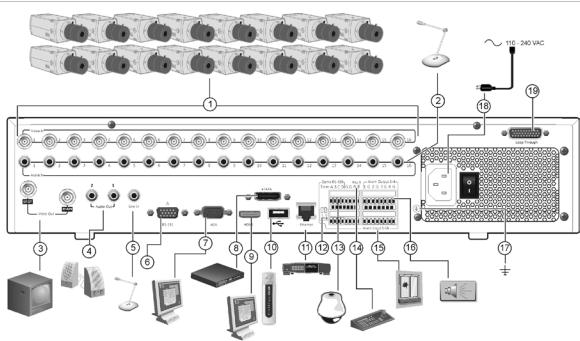
Figure 1: Back panel connections
1.Connect up to 16 analog cameras to BNC connectors (depends on the DVR model).
2.Connect audio inputs (available for each camera) to RCA connectors.
3.Connect up to two CCTV monitors (BNCtype connectors):
-Spot monitor
-Main monitor
4.Connect to speakers for audio output.
5.Connect RCA connector to a microphone.
6.Connect to a RS-232 device.
7.Connect one CCTV monitor (BNC-type connector).
8.Connect to an optional eSATA device such as SATA HDD, CD/DVD-RM.
9.Connect to a HDTV. The HDMI connection supports both digital audio and video.
10.Connect to an optional USB device such as a mouse, CD/DVD burner or HDD. The DVR supports both a USB DVD and a USB HD on the front and back USB ports.
11.Connect to a network.
12.Terminate the line to the dome cameras using this RS-485 switch. Default is Off.
13.Connect to a PTZ control.
14.Connect to a keyboard (KTD-405 shown)
15.Connect up to 16 alarm inputs.
16.Connect up to four alarm relay outputs.
17.Connect to ground.
18.Connect to a power supply.
19.Loop through for up to 16 analog cameras (see item 1).
RS-485 ports
There are two RS-485 ports on the back panel of the DVR. See Figure 2 on page 10 for the serial pin outs.
•Dome RS-485:
A and B: Connect pan, tilt, zoom control of PTZ dome cameras. A = +, B = - C and D: Not used
TruVision DVR 42 User Manual |
9 |

G: Ground of dome camera
G: Ground of keypad
•Keyb: Connect the keypad.
Figure 2: RS-485 pins
RS-232 port
Use the RS-232 port to connect CBR-PB3-POS (point-of-sale) and ATM devices to the DVR. See “Configuring the RS-232 port” on page 132 to configure the port.
Monitor connections
Connect the monitors to the DVR outputs (BNC/VGA/HMDI). The HDMI version is 1.3. The unit provides a 1 Vp-p analog signal. See Figure 1 on page 9 for connecting a monitor to a TVR 42.
The TVR 42 supports up to 1280 × 1024 / 60 Hz resolution in VGA. The monitor resolution should be at least 800 × 600. Adjust your monitor accordingly to this resolution.
Loop through
You can loop through the cameras to equipment such as a matrix, monitors or a second DVR. There are 16 numbered loop-through BNC outputs. See Figure 1 on page 9.
Audio inputs and output
The unit is equipped with 16 audio inputs and two audio outputs. Both the audio output and the audio inputs are line-level. Each 16 audio input is associated with one of the 16 cameras.
10 |
TruVision DVR 42 User Manual |
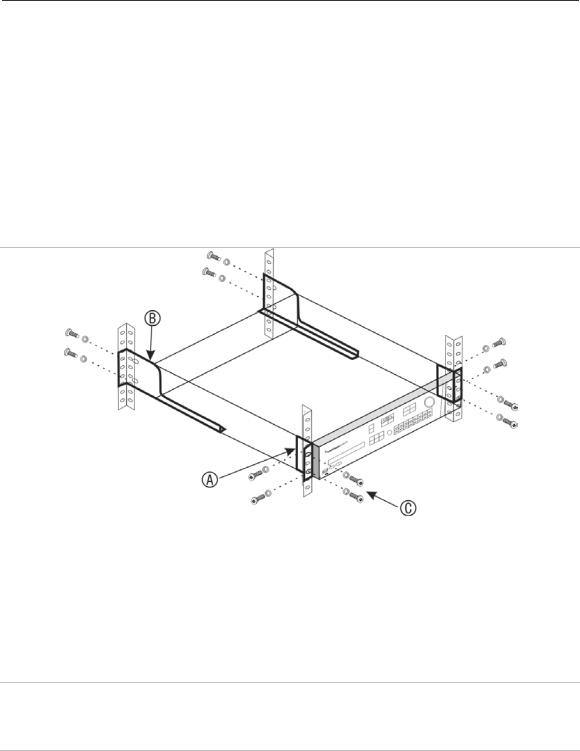
Audio input |
RCA jack, 315 mV, 40 kohms. Unbalanced |
|
|
Audio output |
RCA jack, 315mV, 600 ohms. Unbalanced |
|
|
Note: Line-level audio requires amplification.
Brackets
The DVR is easily rack-mountable with the purchase of the TVR-RK-1 rackmount kit. See Figure 3 below. Contact your local supplier to order it.
Figure 3: Rack-mount installation
To install the racks:
1.Attach the two small front-rack mount ears to the DVR (A). The screws are supplied.
2.Attach the two large rear support brackets (not supplied) to the rear rails (B).
3.Attach the DVR to the front rails (C). The screws are not supplied.
Caution:
Do not rack-mount the TVR 42 without the rear rails installed. Failure to install the rear rails can damage the DVR.
PTZ dome camera set up
Use the USB mouse provided or the optional keypad for local telemetry control. If using the TVR 42 over a network, use the web browser to control the PTZ dome cameras or TruVision Navigator.
TruVision DVR 42 User Manual |
11 |

See Appendix B on page145 for the supported protocols and Appendix F on page 158 for the PTZ commands supported by each protocol.
Each PTZ camera must be set up individually. For information on configuring PTZ dome camera settings, see Chapter 6, “Controlling a PTZ camera” on page 47.
Connecting a TVR 42 to a PTZ dome camera and a keypad
You can connect the KTD-405 or TVK-800 keypad to the DVR. The KTD-405 is a RS-485 bus keypad and the TVK-800 is an IP keypad.
For information on using the TVK-800 keypad, please refer to the TVK-800 user manual.
When connecting the KTD-405 keypad, use the input/output box that is supplied with the keypad to connect a keypad to the TVR 42. The keypad can be connected to a PTZ camera for local control or for control over the network.
See Figure 4 below for the preferred setup. Any PTZ dome camera can be controlled as the DVR is doing the PTZ protocol translation. However, this setup provides only limited dome configuration.
Figure 4: Connecting a KTD-405 keypad to the TVR 42 for control of a PTZ dome camera over the network
Configuring the PTZ protocols for Interlogix cameras
Before the PTZ dome cameras are assembled in their housings, set their protocol and address DIP switches for the TVR 42. See Table 3 on page 13 for different Interlogix PTZ dome camera settings.
If you are using PTZ dome cameras from another company, please refer to their configuration instructions.
12 |
TruVision DVR 42 User Manual |
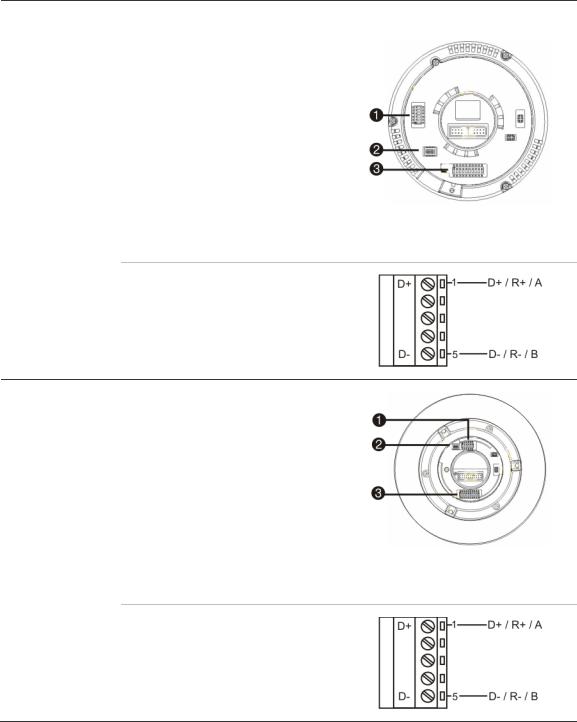
Table 2: PTZ protocols for Interlogix cameras
Camera |
Switch setting |
|
|
|
|
|
|
TruVision Mini PTZ |
Protocol DIP |
000000 |
|
12X: Indoor Dome |
switches: |
|
|
|
|
|
|
|
RS-485 |
0000000000 |
|
|
communication DIP |
|
|
|
switches: |
|
|
|
|
|
|
|
Camera ID DIP |
Select the |
|
|
switches: |
camera ID |
|
|
|
DIP switch |
|
|
|
address as |
|
|
|
required |
|
1. Protocol DIP switches
2. RS-485 communication DIP switches
3. Camera ID DIP switches
RS-485 data connector:
TruVision Mini PTZ |
Protocol DIP |
000000 |
12X: Outdoor |
switches: |
|
Dome |
|
|
|
|
|
|
RS-485 |
0000000000 |
|
communication DIP |
|
|
switches: |
|
|
|
|
|
Camera ID DIP |
Select the |
|
switches: |
camera ID |
|
|
DIP switch |
|
|
address as |
|
|
required. |
1.Protocol DIP switches
2.RS-485 communication DIP switches
3.Camera ID DIP switches
RS-485 data connector:
TruVision DVR 42 User Manual |
13 |

Camera |
Switch setting |
|
|
|
|
|
|
TruVision Dome |
Protocol switches: |
0111 |
|
16X PTZ |
|
|
|
|
|
|
|
|
Address switches: |
Select the |
|
|
|
camera ID |
|
|
|
DIP switch |
|
|
|
address as |
|
|
|
required. |
|
|
|
|
|
|
Baud rate: |
0000 |
|
1. Address switches; 2. Baud switches;
3. Protocol switches
RS-485 data connector:
CyberDome |
Protocol switches: |
NA |
|
|
|
|
Address switches: |
Select the |
|
|
camera ID |
|
|
DIP switch |
|
|
address as |
|
|
required. |
RS-485 data connector:
14 |
TruVision DVR 42 User Manual |
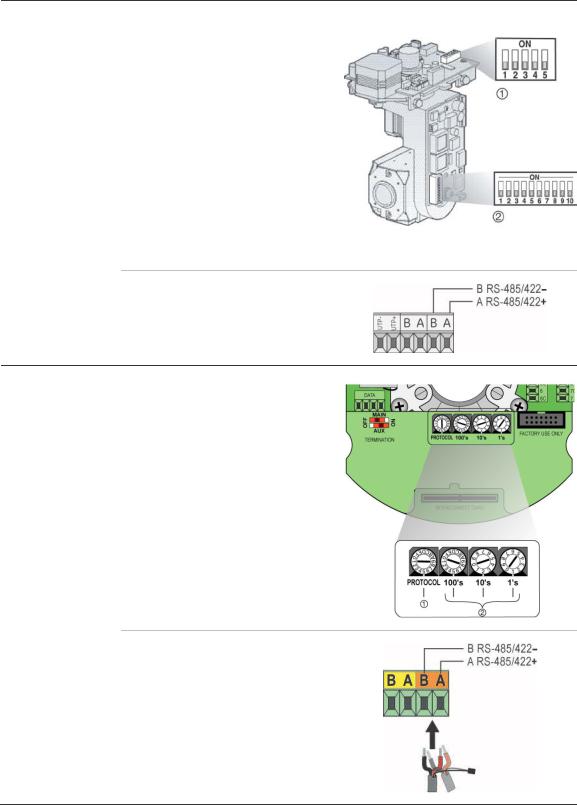
Camera |
Switch setting |
|
|
|
|
|
|
UltraView PTZ |
Protocol switches: |
01000 |
|
|
|
|
|
|
Address switches: |
Select the |
|
|
|
switch |
|
|
|
address as |
|
|
|
required. |
|
1. Protocol switches;
2. Address switches
RS-485 data connector:
Legend |
Protocol switches: |
1 |
|
|
|
|
Address switches: |
Select the |
|
|
camera ID |
|
|
DIP switch |
|
|
address as |
|
|
required. |
RS-485 data connector:
TruVision DVR 42 User Manual |
15 |

Wiring the KTD-405 keypad
The KTD-405 keypad uses RS-485 simplex wiring. The signal is transferred by a single twisted pair line. A shielded STP CAT5 network cable is recommended. Ground one end of the cable, either the first or last device on the RS-485 line.
The maximum number of devices that can be installed in one bus is 255, with a maximum cable length of 1200 m. The cable length can be expanded using a signal distributor.
Both the first and the last device in series should be terminated with 120 Ohm resistance to minimize line reflections. See Figure 5 below.
Figure 5: RS-485 bus serial wiring
1. |
Keypad (KTD-405 keypad shown) |
3. See section “RS-485 ports” on page 9 |
2. |
I/O box |
|
Use an RS-485 signal distributor for a star wiring configuration. See Figure 6 on page 17.
16 |
TruVision DVR 42 User Manual |
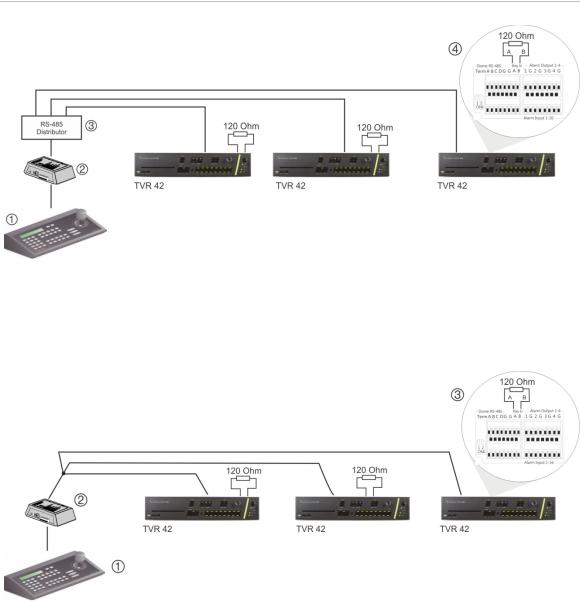
Figure 6: Star wiring with RS-485 signal distributor
Correct:
1. |
Keypad (KTD-405 keypad shown) |
3. |
RS-485 distributor |
2. |
I/O box |
4. |
See section “RS-485 ports” on page 9 |
Incorrect:
1. |
Keypad (KTD-405 keypad shown) |
3. See section “RS-485 ports” on page 9 |
2. |
I/O box |
|
Use an RS-485 signal distributor to increase the maximum number of devices on the bus as well as the total range. Each distributor output provides another RS485 bus, extending the output an additional 1200 m. Up to 31 TVR 42s can be connected to each output. See Figure 7 on page 18.
TruVision DVR 42 User Manual |
17 |
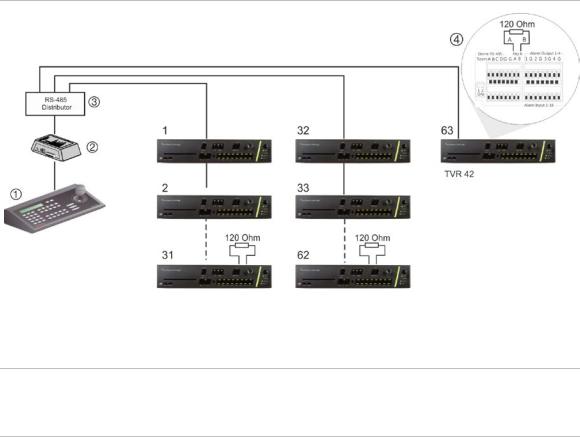
Figure 7: Expanding the system with an RS-485 signal distributor
1. |
Keypad (KTD-405 keypad shown) |
3. |
RS-485 distributor |
2. |
I/O box |
4. |
See section “RS-485 ports” on page 9 |
Caution: Most signal distributors are unidirectional. This means that the signal only flows from the input towards the outputs. Consequently it is not possible to connect several keypads.
See section “RS-485 ports” below to configure the RS-485 port communication settings.
18 |
TruVision DVR 42 User Manual |
Chapter 3
Getting started
Turning on and off the DVR
Before starting the power up process, connect at least one monitor to the BNC, HDMI, or VGA outputs. Otherwise, you will not be able to see the user interface and operate the device. Also connect at least one camera.
The DVR auto-detects the video mode (PAL or NTSC) on startup.
It is equipped with a universal power supply that will auto-sense 110/240 V, 60/50 Hz.
Note: It is recommended that an uninterruptible power supply (UPS) is used in conjunction with the device.
To turn on the DVR:
Turn on the DVR using the power switch on the back panel. A splash screen appears on screen.
Once the TVR 42 is powered up, the indicator bar on the front panel will light up green. All connected cameras are displayed on-screen. The TVR 42 automatically begins recording.
To turn off the DVR:
1.In live view mode, right-click the mouse and click Menu. The main menu window appears.
2.Select the Power Manager icon.
3.In the Shutdown popup menu, select Shutdown. Click Yes to confirm shutdown.
To reboot the DVR:
1.In live view mode, right-click the mouse and click Menu. The main menu window appears.
2.Select the Power Manager icon.
3.In the Shutdown popup menu, select Reboot. Click Yes to confirm shutdown.
TruVision DVR 42 User Manual |
19 |

Using the setup wizard
The TVR 42 has an express installation wizard that lets you easily configure basic DVR settings when first used. It configures all cameras simultaneously. The configuration can then be customized as required.
By default the setup wizard will start once the DVR has loaded. It will walk you through some of the more important settings of your DVR.
Any changes you make to a setup configuration page are saved when you exit the page and return to the main wizard page.
Note: If you want to set up the DVR with default settings only, click Next in each window until the end.
To quickly set up the DVR:
1.Connect all the devices required to the back panel of the DVR. See Figure 1 on page 9.
2.Turn on the unit using the power switch on the back panel. After the boot up window, the DVR displays video images on screen.
3.Select the preferred language for the system from the dropdown list and then click Next.
4.Enable or disable the option to start the wizard automatically when the DVR is turned on. Click Next.
5.Administrator configuration:
Navigate to the Admin Password edit box and click the edit box with the mouse, or press Enter on the front panel or remote control, to display the virtual keyboard. Enter the default admin password, 1234.
Note: You must enter an admin password. To change the Admin password, check New Admin password and enter the new password and confirm it.
Caution: It is strongly recommended that you change the password of the administrator. Do not leave 1234 as the default password. Write it down in a safe place so that you do not forget it.
If you should forget the password to your DVR, contact your supplier with the serial number of your DVR to obtain a secure code to reset your DVR.
Click Next.
6.Time and date configuration:
Select the desired time zone, date format, system time and system date.
Note: Daylight savings time (DST) cannot be configured from the wizard. See “Configuring time and date” on page 42 for more information on DST.
20 |
TruVision DVR 42 User Manual |
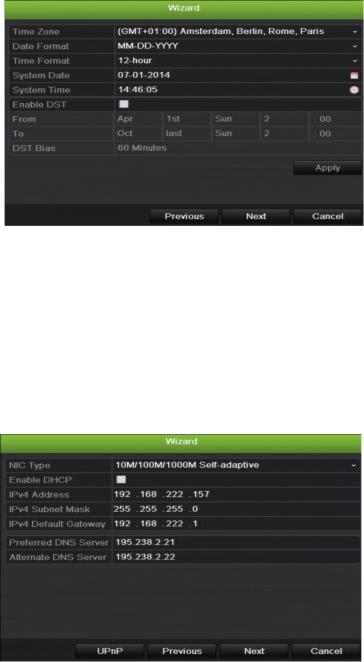
Note: The system time and date are visible on screen. However, they do not appear in recordings.
Click Next to move to the next page, or Previous to return to the previous page.
7.Network configuration:
Configure your network settings such as the NIC type, IP address, subnet mask and default gateway. Enter the preferred DNS server address as well as the alternate one to use.
Click Next to move to the next page, or Previous to return to the previous page.
8.HDD management:
Configure your HDD settings as required.
You can group HDDs and assign cameras to a group. See “Setting up HDD groups” on page 122 for further information. You can also set up a drive for redundant recording. See “HDD redundancy” on page 98.
After configuring your HDD settings, click Initialize to initialize the HDD and
Next to move to the next page, or Previous to return to the previous page.
TruVision DVR 42 User Manual |
21 |
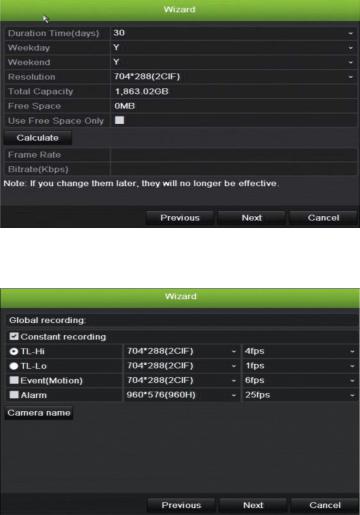
9.Recording configuration:
Configure your recording settings as required. The settings apply to all cameras connected to the DVR. There are two recording configurations:
Auto record settings: The window for “Auto Record Settings” is shown below.
Advanced record settings: The window for “Advanced Record Settings” is shown below.
Check the Constant Recording checkbox for the DVR to record continuously all day. If left unchecked, the DVR will not record.
Check the TL-Hi check box and select its image resolution and frame rate. Check the TL-Lo check box and select its image resolution and frame rate.
To record motion detection events, check Event (Motion) and select the image resolution and frame rate.
To record alarm events, check Alarm and select the image resolution and frame rate.
Under Camera name enter the camera name. A soft keyboard will appear to enter the characters.
10.When all the required changes have been entered, a page appears showing all the settings.
22 |
TruVision DVR 42 User Manual |

Click Finish to exit the Wizard. The TVR 42 is now ready to use.
TruVision DVR 42 User Manual |
23 |
Chapter 4
Operating instructions
Controlling the TVR 42
There are several ways to control the DVR:
•Front panel control
•Mouse control
•IR remote control
•KTD-405 keypad control (see Appendix)
•Web browser control
You can use your preferred control method for any procedure, but in most cases we describe procedures using mouse terminology. Optional control methods are given only when they differ substantially from mouse control methods.
Using the front panel
The function buttons on the front panel control can be used to operate many, but not all, of the main functions of the DVR. The LED indicators light up to alert you of various conditions. The functions available can be limited by setting passwords. See Figure 8 on page 25 for more information.
24 |
TruVision DVR 42 User Manual |
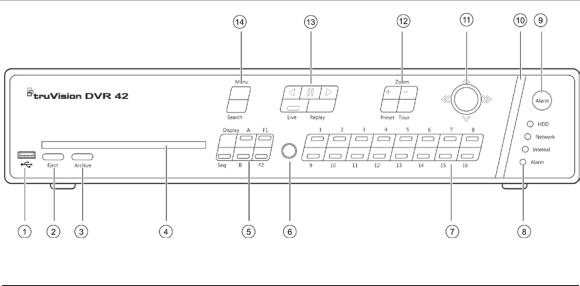
Figure 8: Front panel
The controls on the front panel include:
Item |
Name |
Description |
|
|
|
1. |
USB port |
The recorder supports additional devices such as a USB |
|
|
mouse, CD/DVD burner, and a USB HDD on the front |
|
|
and rear USB ports. |
|
|
|
2. |
Eject button |
Ejects CD/DVD disc. |
|
|
|
3. |
Archive button |
Press once to enter quick archive mode. Press twice to |
|
|
start archiving. |
|
|
|
4. |
CD/DVD slot |
Insert a CD or DVD disc. |
|
|
|
5. |
Display buttons |
Display: Toggles through the various multiviews: full, |
|
|
quad, 1+5, 1+7, 9, and 16. |
|
|
Sequence: Starts/stops sequencing in live view mode. |
|
|
A: Selects the main monitor. |
|
|
B: Selects the spot monitor (in live view). |
|
|
F1: In all-day playback, click to start and stop video |
|
|
clipping. |
|
|
F2: In live view mode, click to display/hide the time bar. |
|
|
In all-day playback, click to hide/display the playback |
|
|
control toolbar. |
|
|
|
6. |
IR receiver |
Receiver for IR remote. |
|
|
|
7. |
Channel buttons |
Switch between different cameras in live, PTZ control or |
|
|
playback modes. Use the soft keyboard to enter |
|
|
numerals 0 to 9. |
TruVision DVR 42 User Manual |
25 |

Item |
Name |
Description |
|
|
|
8. |
Status LEDs |
HDD: A steady green light indicates that the recorder is |
|
|
accessing the HDD in read or write mode. A steady red |
|
|
indicates a HDD failure. |
|
|
Network: A steady green light indicates that the |
|
|
recorder is currently connected to a network. No light |
|
|
indicates that it is not connected to a network. |
|
|
Internal: A steady green light indicates that the recorder |
|
|
is recording video or audio. No light means that it is not |
|
|
recording. A steady red light means that there has been |
|
|
an internal health failure. |
|
|
Alarm: A steady red light indicates that there is a sensor |
|
|
Alarm In or other alarm such as motion detection or |
|
|
tampering. A steady green light means there is no |
|
|
alarm. |
|
|
|
9. |
Alarm button |
Use to manually acknowledge an alarm. In live view |
|
|
mode, use it to call the alarm recipient. |
|
|
|
10. |
Alarm indicator bar |
Blinking red indicates that there is an alarm. |
|
|
|
11. |
Joystick |
Use to select options in a menu and to control playback. |
|
|
Press for Enter. The LED arrows are lit when the jog is |
|
|
active. |
|
|
Live view mode: Press Enter to enter/exit PTZ mode. |
|
|
Menu mode: Move the joystick left/right and up/down to |
|
|
position cursor in the menu window. Press for Enter. |
|
|
Playback mode: Move the joystick left/right to slow |
|
|
down or speed up playback. Move it up/down to jump |
|
|
forwards or backwards by 30 seconds. Press Enter to |
|
|
stop/start playback. |
|
|
PTZ mode: |
|
|
Move the joystick to control the movement of the PTZ |
|
|
dome camera. Move the joystick left/right to slow down |
|
|
or speed up PTZ. Move it up/down to jump forwards or |
|
|
backwards by 30 seconds. |
|
|
|
12. |
PTZ buttons |
Zoom: Use + and – for digital zoom. |
|
|
Preset: Call up preprogrammed preset positions. |
|
|
Tour: Call up preprogrammed shadow tours. |
|
|
|
13. |
Playback buttons |
Reverse: In live view mode, press to jump back to |
|
|
the oldest available video and start play back. In |
playback mode, press to play back video in reverse. In snapshot playback mode, view snapshots in the reverse direction.
 Pause: In live view mode, freeze the last image of the live video. In playback mode, pause playback.
Pause: In live view mode, freeze the last image of the live video. In playback mode, pause playback.
 Forward: In live view mode, press to start all-day playback of the currently selected camera. If you are in multiview format, only the camera shown in the top-left corner of the multiview is played back
Forward: In live view mode, press to start all-day playback of the currently selected camera. If you are in multiview format, only the camera shown in the top-left corner of the multiview is played back
Live: Switch to live view mode.
Replay: Replay the current file in playback Starts at the beginning of the file.
26 |
TruVision DVR 42 User Manual |

Item |
Name |
Description |
14.Menu and Search buttons Menu: Enter/exit the main menu.
Search: In live view mode, enter the advanced search menu.
Using the mouse
The USB mouse provided with the DVR can be used to operate all the functions of the DVR, unlike the front panel which has limited functionality. The USB mouse lets you navigate and make changes to settings in the user interface.
Connect the mouse to the DVR by plugging the mouse USB connector into the USB port on the back or front panel. The mouse is immediately operational and the pointer should appear.
Note: Use a USB 1.1 or higher mouse.
Move the pointer to a command, option, or button on a window. Click the left mouse button to enter or confirm a selection.
You can purchase a spare mouse by ordering part number TVR-MOUSE-1. See Table 4 below for a description of the mouse buttons.
Table 3: Mouse buttons
Item |
Description |
|
|
|
|
Left button |
Single-click |
Live view: Select a camera to display the quick |
|
|
access toolbar (see “Accessing frequently used |
|
|
commands” on page 37). |
|
|
Menu: Select a component of a menu, such as a |
|
|
button or an input field. This is similar to pressing the |
|
|
Enter button on the remote/front panel controls. |
|
|
|
|
Double-click |
Live view: Switch between single screen and multi- |
|
|
screen mode in live/ playback mode. |
|
Click and drag |
Live view: Drag channel/time bar. |
|
|
PTZ control: Adjust pan, tilt and zoom. |
|
|
Tamperproof, privacy masking and motion |
|
|
detection functions: Select the target area. |
|
|
Digital zoom-in: Drag and select target area. |
|
|
|
Right button |
Single-click |
Live view: Display menu. |
|
|
Menu: Exit the current menu and return to higher |
|
|
level. |
|
|
|
Scroll-wheel |
Scroll up |
Live view: Return to the previous window. |
|
|
Menu: Move the selection to the previous item. |
|
|
|
|
Scroll down |
Live view: Move to the next window. |
|
|
Menu: Move the selection to the next item. |
|
|
|
TruVision DVR 42 User Manual |
27 |
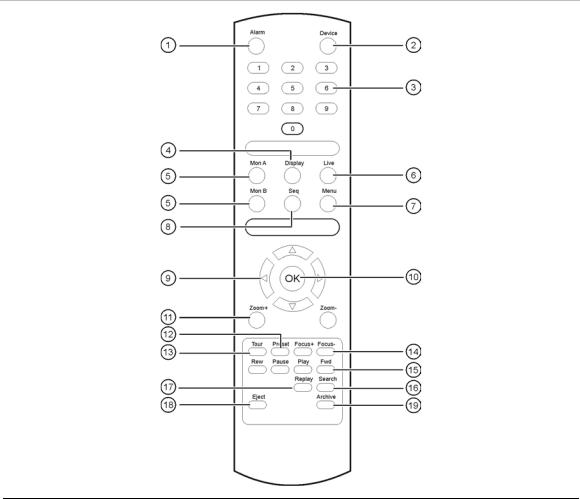
Using the IR remote control
The TVR 42 is supplied with an infra red (IR) remote control unit. Like the mouse, it can be used to operate all of the main functions of the TVR 42.
The IR remote control can be programmed with a unique device ID address so that the controller will only be able to communicate with DVRs with that address. No programming is necessary if using a single TVR 42.
The device ID address only applies when using a remote control and not when using a keypad.
You can purchase a remote control by ordering part number TVR-REMOTE-1.
Figure 9: IR remote control
Item |
Description |
|
|
|
|
1. |
Alarm |
Acknowledge an alarm. |
|
|
|
2. |
Device |
Enable/disable the IR remote control to control the TVR 42. |
|
|
|
3. |
Numeric buttons |
Select a camera, and enter a number in a menu option. |
|
|
|
4. |
Display |
Switch between the different multiviews. |
|
|
|
5. |
Mon A and Mon B Switch between monitors A and B. |
|
|
|
|
6. |
Live |
Return to live view mode. |
|
|
|
28 |
|
TruVision DVR 42 User Manual |
